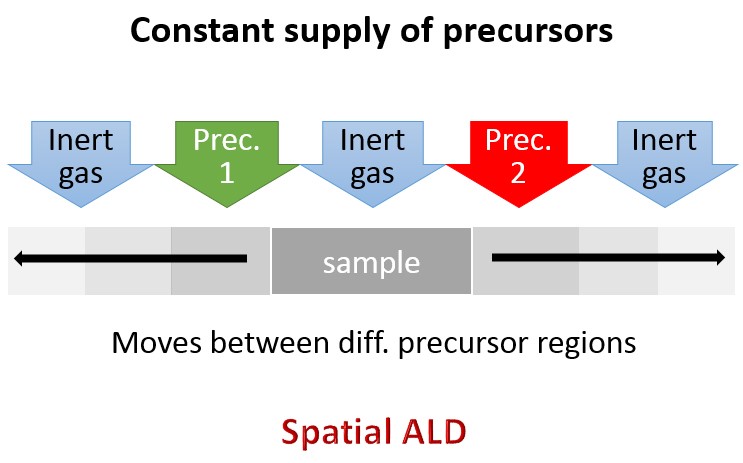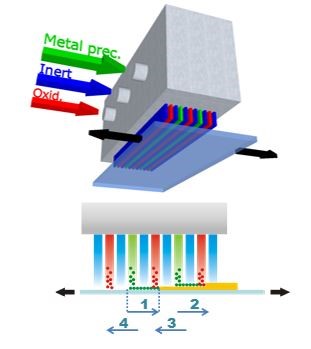“Harnessing heat and light to sustainably power the Internet of Things”
A new article has been published by our partners FETFX on the project activities.
PhD position at LMGP/LEPMI Grenoble
Interested in being part of Harvestore? The Materials and Physical Engineering Laboratory (LMGP) and the Laboratory of Electrochemistry and Physical-Chemistry of Materials and Interfaces (LEPMI) in Grenoble offer a PhD project on design and characterization of advances energy materials for micro-cell applications. Check this out!
Atmospheric pressure Spatial Atomic Layer Deposition (AP-SALD)
AP-SALD is a rather recent alternative approach to ALD that is faster (up to two orders of magnitude) and less expensive (since it can be easily implemented at atmospheric pressure) than ALD. This opens new fields of industrial applications for flexible and large substrates (OLEDs, flat displays, photovoltaic cells, etc).
In SALD, the precursors are dosed continuously in different locations (separation of precursors in space), thus eliminating the need for the purge steps of conventional ALD (where precursors are separated in time, Figure 1). This results in much faster deposition rates than conventional ALD (up to two orders of magnitude, reaching nm/s). In addition, SALD offers plenty of flexibility in terms of design and is fully compatible with high throughput processing methods such as roll-to-roll. Finally, because it can be implemented easily at atmospheric pressure, it can be readily scalable as well. As a result, SALD is receiving increasing interest and attention over the last years since it has the potential to become a widespread laboratory and industrial deposition method for multiple applications including electronics, optoelectronics, textiles, paper, etc.
![[legende-image]1383921695955[/legende-image]](https://harvestore.eu/wp-content/uploads/2020/03/tald-pic.jpg)

The Materials and Physical Engineering laboratory in Grenoble (LMGP, a mixed unit between the CNRS and Grenoble INP), partner of Harvestore, if one of the few groups to develop SALD around the world. The approach used is based on a gas injection manifold where the precursor and inert gas are distributed along parallel channels, the close proximity of the substrate ensuring and efficient separation of the precursors, as shown schematically in Figure 2.

The LMGP designs and develops its own systems, and currently has a first prototype that has been working since 2015, while a second one is currently being implemented for large area deposition (tens of cm2). The materials already available are ZnO, Al2O3, Al:ZnO, TiO2, MnO, Cu2O, and SiOx.
The SALD team is currently developing new materials to be applied to the deposition of components for micro harvestorers, and to demonstrate large-area, high –throughput fabrication of such devices.
More information on the research related to SALD in the LMGP can be found in the following links and references below:
http://www.lmgp.grenoble-inp.fr/en/research/spatial-ald
http://www.lmgp.grenoble-inp.fr/en/research/spatial-atomic-layer-deposition
Refs:
- Muñoz-Rojas D, Maindron T, Esteve A, Piallat F, Kools JCS, Decams J. Speeding up the unique assets of atomic layer deposition. Mater Today Chem. 2019;12:96–120.
- Muñoz-Rojas D, Viet Huong Nguyen, Masse de la Huerta C, Jiménez C, Bellet D. Spatial Atomic Layer Deposition. In: Chemical Vapor Deposition for Nanotechnology. Intech open; 2019. OPEN ACCESS : https://www.intechopen.com/books/chemical-vapor-deposition-for-nanotechnology/spatial-atomic-layer-deposition
- Muñoz-Rojas D, MacManus-Driscoll J. Spatial atmospheric atomic layer deposition: a new laboratory and industrial tool for low-cost photovoltaics. Mater Horizons [Internet]. 2014; 1: 314–20.
Article by David Muñoz-Rojas.
“The power of Interfaces” workshop
The first edition of the joint Harvestore-SOIFIT worskhop “The Power of Interfaces: Fundamentals for Solid State Devices” will take place at the hystorical Royal Society in London next March 10th and 11th. Some of the most influential scientists in the field will be present…check out the program and sign up! https://www.imperial.ac.uk/events/95807/the-power-of-interfaces-fundamentals-for-solid-state-devices/
Joint project Harvestore-GoNano
The project has built up a collaboration with an ongoing H2020 project on Governing Nanotechnologies Through Societal Engagement “GoNano” (http://gonano-project.eu/) with an aim to identify potential flaws/untapped markets and opportunities. Particularly, the collaboration enables project co-creation between citizens, researchers, industry, civil society organisations, and policy makers across Europe to align future nanotechnologies with societal needs and concerns. On October 30th, a joint workshop between the two projects has been organized at IREC, with the participation of several partners from Harvestore (IREC, ICL) and of professionals in the field as potential stakeholders.
News communication by Worldsensing
The project partner Worldsensing has released a news article for introduction and for describing their role in the project:
December appointments in Italy
Today we have been hosted by Prof. Lughi (Dept. of Engineering and Architecture) at the University of Trieste for a seminar on hydrogen-based technology, device and future applications. Tomorrow and on Wednesday we will participate in a Joint School on Scientific Data management.
European Researcher’s Night
Harvestore will be present with his “Power on your fingertip” activites during the European Researcher’s Night at Cosmocaixa forums in Barcelona and Zaragoza. A suitcase of fun! Download the program flyer here.
Job opening at CNRS Grenoble
The group of Dr. Monica Burriel “Oxides for Nanoioncs Devices” (Grenoble, France) is looking for a postodoctoral researcher to work on the development of electrochemical materials and on their advanced characterization within the framework of the Harvestore project. More info here!
Harvestore at E-MRS Fall Meeting
A big participation from the project is planned for E-MRS Meeting 2019, to be held in Warsaw from Sept. 16th to 19th. Harvestore will sponsor the symposium A: “Ion-related phenomena in nanoscale systems: From fundamentals to applications” and will be present for a dedicated session in the same symposium on Tuesday afternoon, starting at 9 am. Several related talks will be presented by project partners…follow us on Twitter for the latest news!
